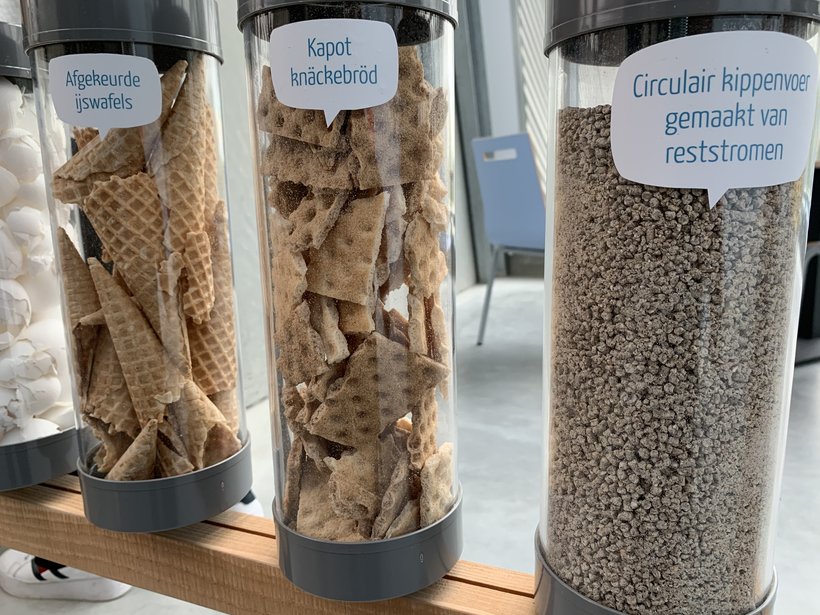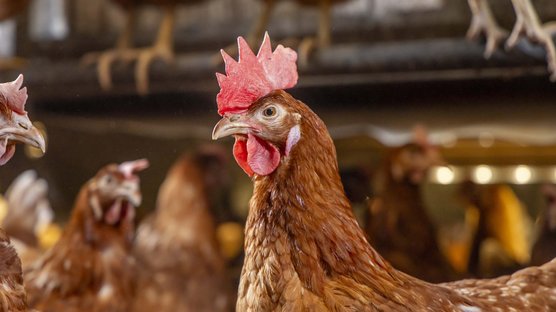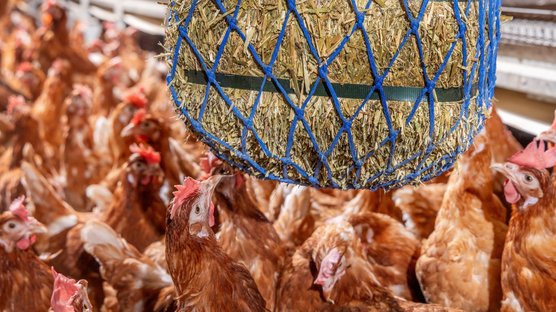
Published on May 28, 2025
The effect of bakery by-products on digestion, hen health, and egg laying performance
There is a growing interest from the global animal-feed industry to lower the carbon footprint of the production of eggs or poultry meat via the feed. As feed has the highest impact on the carbon footprint of egg production, there is great potential to make a significant reduction via including cost-effective and sustainable feed ingredients.
When looking at alternative ingredients, the overall goal of the diet should be the same, it should not compromise on egg production, nor have negative consequences on the overall health and wellbeing of the chickens. In particular, the chicken’s gut health should be maintained. One of the more recent alternatives that are being looked at to include in today’s chicken diets are the so called bakery by-products, like bread and cookie meal. Various of the bakery by-products can be interesting alternative feed ingredients, as these bakery by-products offer a rich source of carbohydrates and fats. However, prior to including bakery by-products in any laying hen diet, you need to be aware about their effects on digestion, microbial populations, gut health and overall performance.
Digestion and nutrient utilization
Bakery by-products like bread and cookie meal, contain significant amounts of rapidly digestible sugars and carbohydrates. The digestion rate of these carbohydrates directly affects the energy utilization and the microbial balance in the gastrointestinal tract. Unlike complex carbohydrates such as fiber, simple sugars, that can often be found in bakery by-products, are absorbed quickly. Rapid digestion of sugars may increase metabolic energy availability but could also result in inefficient nutrient absorption if not properly balanced with other dietary components. Further the digestibility of most of the bakery by-products is lower. Let’s take maize as an example. On average the digestibility of bread meal, cookie meal and maize is 83%, 78% and 83% for protein and 78%, 82% and 84% for fat, respectively (CVB, 2023)
Impact on chicken gut health, the role of gut microbial populations
In chickens, the gut microbiota plays a crucial role in digestion and overall hen health. The inclusion of high-sugar diets from bakery by-products can alter microbial populations, potentially favouring pathogenic bacteria when not managed correctly. Rapid fermentation of simple sugars in the hindgut can lead to dysbiosis, where beneficial bacteria such as Lactobacillus and Bifidobacterium decline while opportunistic pathogens like Clostridium perfringens proliferate. This imbalance can increase the risk of enteric diseases that compromise nutrient absorption, negatively impacting egg production, egg quality, manure quality, feather cover, and livability.
Variation and potential risks in bakery by-products
Due to the diverse raw materials and processing techniques involved in bakery by-products, there is a considerable variation in nutrient composition, moisture content, and shelf life stability. As highlighted in Smith et al. (2004), bakery products range from low to high moisture and high moisture products have increased susceptibility to microbial contamination, including mold and yeast growth. This variability introduces potential risks when formulating poultry diets, as inconsistent nutrient profiles could result in under- or over-supply of critical nutrients. In table 1 the average levels and the variation (expressed as standard deviation) is shown for bread meal, cookie meal and maize. The variation in bakery by-products is higher compared to maize. In general the variation is between batches and between suppliers. As an example, it really depends whether cookies, that are high in sugar, or rice waffles are being included in the poultry diets, as the source of the bakery by-product has a huge effect on the sugar content. It is highly recommended to aim for a consistent composition and nutritional value during the entire laying cycle, to minimize the impact on chicken health and performance between the various chicken feed batches.
| Bread meal | Cookie meal | Maize | |
|---|---|---|---|
|
Crude protein |
124 ± 7 | 91 ± 7 | 75 ± 4 |
|
Crude fat |
44 ± 10 | 102 ± 10 | 37 ± 4 |
| Sugar | 68 ± 12 | 115 ± 21 | 13 ± 3 |
| Starch | 520 ± 20 | 415 ± 46 | 640 ± 9 |
There is a risk of oxidative rancidity in bakery by-products if they are high in their fat content. As bakery products age, unsaturated fats may degrade, causing rancidity that could impair feed palatability, but also taste, thereby reducing overall feed intake. Proper handling and proper storage of bakery by-products are both essential to mitigate the risk of the occurrence of oxidative rancidity.
The role of fatty acid composition in bakery by-products
Bakery by-products contain a mix of unsaturated and saturated fatty acids. Unsaturated fatty acids (C16:1 + C18:1 + C18:2 + C18:3), particularly originating from vegetable oils, have a higher fat digestibility compared to saturated fats (C16:0 + C18:0). The saturated fats are coming predominantly from animal origin. An optimal U:S ratio is important to optimize the digestion and therefore dietary energy, which is even more important in chickens during the rearing period birds compared to older laying hens. Therefor it matters to know the ingredient composition of the bakery by-products. Cookie meal can be given an as a clear example to highlight the importance of understanding the ingredients. As dairy butter and margarine differ in there U:S ratio, and thereby will also in digestibility of the cookie meal.
Effect on performance and egg production
Scientific research about the use of bakery by-products in laying hen diets is limited or only very recent, but if properly formulated, bakery by-products can be included in pullet and laying hen diets at moderate inclusion levels (5–10%) without affecting performance negatively. However, excessive inclusion may lead to energy imbalances, resulting in overweight hens, or altered speed of digestion, resulting in chicken gut health issues or an increased risk for overall egg laying performance when purchasing a variable product. Further, the particle size of bakery by-products is extremely fine, reducing the overall feed particle size of the chicken feed. Management applications, like empty feeding technique, need to be considered to prevent selective eating by the pullets or laying hens.
Conclusion
Bakery by-products, like bread and cookie meal, can serve as valuable alternative feed ingredients for laying hens when included in appropriate amounts. The rapid digestion of sugars (cookie meal) necessitates careful diet formulation to avoid metabolic imbalances and microbial dysbiosis. Furthermore, the fatty acid profile of the bakery by-products must be considered, with a preference for unsaturated fats. As the unsaturated fatty acids will promote better health and productivity of the laying hens. As the inclusion of bakery by-products can lower the overall carbon footprint of poultry diets, the strategic use of these bakery by-products can enhance sustainability in poultry nutrition whilst maintaining optimal egg laying performance and overall hen well-being. Overall sustainability of poultry diets will be further improved as a growing number of research is conducted on the inclusion of bakery by-products and alternative feed ingredients in poultry diets.
References
- CVB. (2023). CVB Veevoedertabel 2023 - Chemische samenstellingen en nutritionele waarden van voedermiddelen. Stichting CVB.
- Smith, J. P., Daifas, D. P., El-Khoury, W., Koukoutsis, J., & El-Khoury, A. (2004). Shelf life and safety concerns of bakery products—A review. Critical Reviews in Food Science and Nutrition, 44(1), 19-55.



